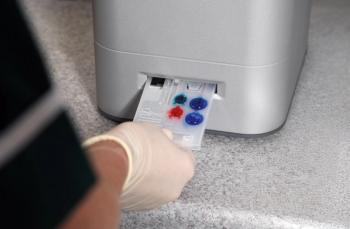
Toiling to catch up with technology
One practice's struggle to update their practice-management software proves highly worthwhile.
SINCE WE'RE BASED IN PALM SPRINGS, Calif., the Animal Medical Hospital has a clientele of movie stars, famous musicians, and many ordinary pet owners who want the best for their animals. We treat more than 13,400 pets with the help of one part-time and three full-time doctors, plus 21 additional team members.
In the end, the benefits outweighed team members struggles
But dedication and a skilled staff aren't the only factors driving our success. Our use of practice-management software has been an operational mainstay for years. And recent breakthroughs in software developed specifically for today's clinic environment have taken us beyond the realm of a tracking-and-billing system to one that drives increased quality of health care, better client service, and increased profits.
Yet finding this technology and incorporating it into our practice proved quite the struggle.
In the process we lost valuable team members, spent countless hours in frustration, and faced very real fears about technology and change.
The heel-dragging syndrome
Like many clinics, we had a practice-management system that was adequate at one time but had long since passed the point of optimal usefulness. And, like many veterinarians, my partner and I dragged our heels on upgrading. We were running a busy clinic, after all. The time, training, and angst involved in selecting and transitioning to a new system caused us to make do with what we had—that is, until I experienced a wake-up call.
I signed up for a course on the Veterinary Information Network given by consultant Dr. Thomas Catanzaro, Dipl. ACHE, who's dedicated to educating clinics on "best practices" for healthcare delivery and practice management. I emailed "Tom Cat," as he's known to colleagues, to share the challenges facing our clinic. Our discussions helped clarify our practice goals and showed me how our current processes—and our technology underpinnings—were standing in the way of progress. Through our discussions, we established a set of goals and subsequent challenges.
1. Goal: Provide a clinic setting in which clients feel comfortable dealing with any of the skilled veterinarians on staff, rather than always relying on a specific doctor.
Challenge: While our current practice-management system provided automated billing and basic record tracking, we still depended on handwritten medical records. Deciphering each other's handwriting wasn't easy, and since we couldn't come up to speed quickly on a pet's medical records, we couldn't seamlessly serve clients.
2. Goal: Increase quality of care through better medical-record tracking, reminders, and follow-up.
Challenge: Again, technology was impeding our progress, because our current practice-management system was oriented more toward billing than capturing, tracking, and flagging medical records. Once again, we were too often forced to rely on handwritten records to determine treatment history—leaving us unable to meet the high-quality standards of care we'd set for ourselves.
3. Goal: Drive better business efficiency to enable growth and achieve increased profits for the practice. One issue: If we could decrease missed charges and increase profits, we'd be able to invest in new equipment and medical processes that could benefit our clientele.
Challenge: With the number of pets and clients that we serve, there was no way to increase productivity and decrease the human error that leads to inefficiency and missed charges without moving beyond our current system. So we realized we needed software that would automate the record-keeping process and mirror our clinic workflow.
Out with the old
Once we'd evaluated our situation, we knew we had to make a change—and we looked literally around the world for the right technology vendor. Based on our goals and current challenges, we asked an array of questions that spoke to our clinic's particular needs:
- Will the system let us truly automate and manage medical records from the time a client walks in the door to the time he or she checks out?
- Can we find a way to virtually eliminate handwritten charts and keep all veterinarian-specific notes online with the pet's medical record?
- Can we set automatic alerts and reminders regarding vaccinations and other quality-of-care standards?
- Can we automatically flag special conditions, for example, a pet's allergic reactions to medication?
- Can we reduce human error by using this new system? Will the new software support our goal to reduce missed charges?
- Can we customize the system and individualize screens to fit our particular clinic workflow?
- Is there a search capacity that lets us easily locate information related to a particular pet or client?
- Will our team members be able to adapt to the system and find that it directly benefits their daily work?
- Is the vendor willing to work with us, listen to us, and provide the kind of ongoing partnership and support we need?
Our search quickly narrowed to two vendors. Ultimately, we selected software that was centered on medical records and workflow management—the areas that were key to achieving our clinic goals. Once the decision was made, we faced a few new challenges: adding five workstations—an expansion from five existing stations—and upgrading our server.
Preparing for the change
We transitioned to the new system in September 2004, but before then, we took steps to prepare and involve our team members. We held meetings prior to the changeover to educate our team about the system's features and to explain how the new technology would benefit each staff function. We also handed out copies of Who Moved My Cheese, the bestseller by Spencer Johnson, which details the challenges and rewards of change in the workplace. In one case this careful preparation had unintended results, causing a longtime staff member to thoughtfully reassess the priorities in her life and decide to retire!
The installation and training process took four days, and while there were temporary disruptions to normal operations, we found our clients distinctly unruffled by the process. However, our team was a different story.
The software supplier held group-training sessions for our team followed by one-on-one training support to help ensure staff members were as comfortable as possible the day we went live. Unfortunately, during the first two days of training, we had two long-term receptionists quit. And some doctors and technicians also felt a lot of angst. Suddenly, they were faced with a computer terminal instead of paper files—an intimidating prospect, particularly for those who lacked experience with computers.
The frustrations and the payoff
Aside from learning the new program, the main challenge for our doctors was to increase the thoroughness of their records. They were faced with a SOAP template for each animal exam, so the records required more time to complete. But the benefit was clear: thorough records that can be easily transitioned from doctor to doctor with no more difficulties deciphering people's handwriting or guessing about the patient's treatment plan.
Overall, the hardest part of the process was simply staying the course. There were some compatibility problems with our network and the software, which took some time to resolve. And during the transition, staff members felt discouraged, thinking the old way was easier.
Those of us who saw the value of the new system had to do a lot of cheerleading. We learned the system ourselves and then enthusiastically taught the others.
As we look back, it's clear that upgrading was a wise decision—despite its frustrations. Thanks to the technical support offered by our provider, we could solve problems as they arose and adapt the software to our needs.
It's critical to track results of a change this major. Fortunately, I saw payback in the new system from Day 1. The ability to automate medical records (no more handwritten notes to decipher!) and to mirror our clinic workflow was a huge plus. We can serve clients more quickly and effectively; for example, if another doctor happens to see a client I last worked with, he can review the online record to come up to speed quickly.
And there's no more brushing by the issue of vaccinations; our staff is alerted when a pet isn't up-to-date. The ability to print out customized, take-home instructions is a major benefit to our clients and their pets—it means our care doesn't end when they leave the clinic.
Of all the benefits, workflow management is perhaps the most valuable aspect of the new system. A patient's record travels through various workstations as the pet moves through the clinic—from the front desk, to the exam room, to the lab or surgery, and back to checkout. Staff productivity is up, human error is down, and our team serves pets and clients more quickly and comprehensively.
Dr. Douglas Kunz is a partner at Animal Medical Hospital in Palm Springs, Calif. Send questions or comments to
Newsletter
From exam room tips to practice management insights, get trusted veterinary news delivered straight to your inbox—subscribe to dvm360.




